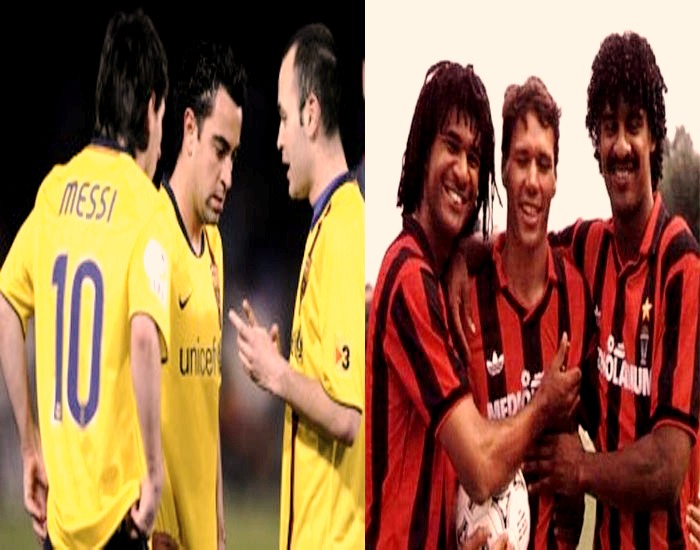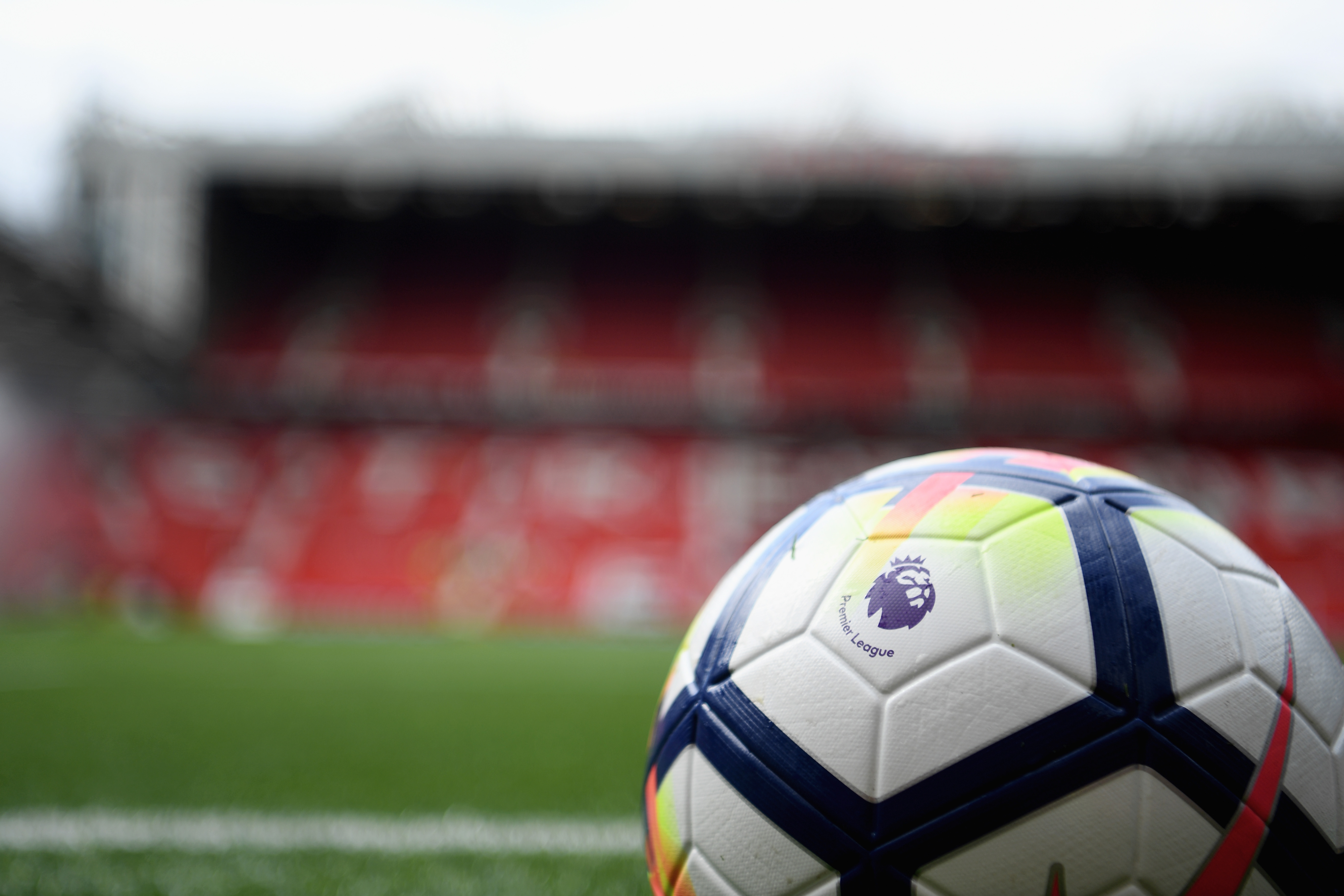“Rhetoric: The considering of two things with regard to some characteristic that is common to both.”
In the purest bibliophilic notes, the aforementioned is the definition of the word ‘comparison’. Even the most ardent adherents of purism have failed to remain aloft to this term. It is billed pretty much human to draw parallels among just about everything even at the slightest of possibilities. Never mind the repetition of preaching one undergoes about how immaterial it is to weigh two magnanimous quiddities against each other, one seldom resists the temptation to doing so and thus ends up unwillingly diminishing the sheer charm an honest and pristine admiration devoid of any collation would bring.
The world of sport is one place where exuberantly high concentrated dose of emotions bubbles around and the vehemence with which several teams and individuals are revered knows no bounds of sanctimony. People who feel being attached to teams representing the land of their origins, who more profoundly refer to themselves as fans, usually relish at the idea of deriving pleasure out of belittling the sentiments worn by rival communities. The most effective means to corroborate such superiority is by compounding the arguments into form of some sort of comparison. This phenomenon that arouses the urge to compare entities is mainly independent of the nature of sport.
Sachin Tendulkar, for all the brilliance he has maintained over a career spanned over two decades, has been subject to sometimes rather unfair comparison with the likes ranging from Sir Don Bradman to Brian Lara. The moment Roger Federer started being acknowledged as the most influential player of the decade just concluded, analogizing process with erstwhile superstars like Bjorn Borg, John McEnroe and Boris Becker spurred up among the premier tennis circles. The most prominent of the comparing antics has been that of juxtaposing individuals or teams of different era, comparing them over some common set of attributes, concluding upon who claims superiority.
In the European club football scene, the domination of Spanish giants FC Barcelona in recent years has compelled the unavoidable debate to resurface among the football forums. The aura that Pep Guardiola’s dream team has created around itself has not simply emerged out of the silverware they claimed but has got more to do with the philosophy of beautiful football that they have quite religiously been practicing. The club’s value system and foundations have worked wonders and the presence of as many as eight academy graduates reserving their places in the first choice team could not have been more elaborative of the fact.
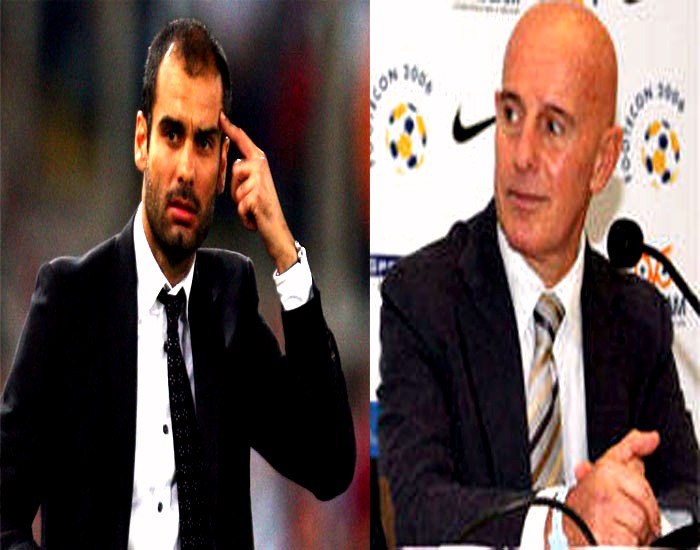
With the brand of football on exhibition and the club ideals taking precedence over anything else at Camp Nou, the very obvious semblance that strikes one’s mind is with Arrigo Sacchi’s Milan juggernaut that successfully claimed the two back-to-back European cups during the years 1988-90. Pretty much similar to the present day Catalonian outfit, the Rossoneri of the yesteryears too boasted of a string of academy products into Sacchi’s choice of players and the amalgam was highly balanced with the presence of foreigners of highest repute. Both the teams, in their eras of supremacy, have demonstrated an unprecedented elegance and are thus, pretty aptly considered two of the greatest club sides ever to have assembled.
TheHardTackle aims at placing the two teams into a hypothetical contention for superiority to assess a comparative analysis of how adaptive, tactically flexible and physically strengthened the two teams may remain while locking horns in an imaginary mode.
Similar Philosophies; Yet Difference in Implementation
They say the greatest of teams in the history of beautiful game did not just win; they did it with some panache – an aspect that very much connects the merry men of both Arrigo Sacchi and Josep Guardiola. The eye-catching speciality of the present day Barcelona’s game lies in their strength to hold on to possession. The Spanish champions have managed to hold a tremendous edge in terms of ball possession even against some of the most physical defenses in Europe. The tiki-taka brand of football, which was originally incepted during the Cruyff days in Catalonia, has been successfully woven into the Barcelona DNA over the three-year period since Guardiola assumed the managerial cloak.
In Xavi and Iniesta, Barcelona boasts of two of the greatest ever creative geniuses of the game. Their immaculate vision for pass and an uncanny knack to free the players in attacking third off their markers is a visual delight, speaking the least. The possession-powered tactics employed quite rigorously by the team week-in week-out, has over the period ensured a protective shield to the apparent shortcomings in the defense on flanks.
Arrigo Sacchi’s Milan side on the other hand, deployed tactics that were somewhat similar in nature but the core strength of the team lay in the best ever defensive assemblage in Europe’s club football history. The rock solid all-Italian defensive wall made up of Tassoti, Costacurta, Baresi and Maldini provided the centre midfield made up of Rijkaard and Ancelotti the liberty to advance past the defensive layer of opposition midfield which would subsequently allow Colombo and Donadoni ample time and space to position themselves as inverted wingers.
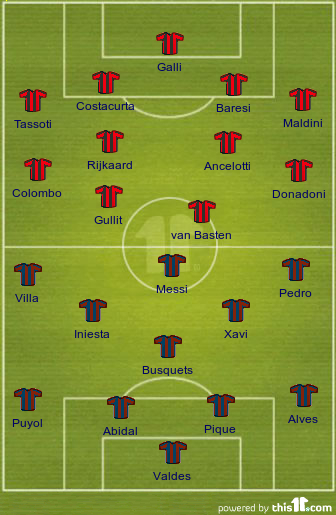
The pressing tactics of both the teams can be termed somewhat similar, if not exactly identical as both sets of players heavily rely on quick passing and possession maintenance. Sacchi’s idea of 25-meter distance between the centre back and the centre forward demanded the team to hold a tremendously high line even while defending and which pushed the midfield further up the pitch to penetrate into the opposition’s half. The defensive prowess of the Rossoneri was potent enough for the midfield to enjoy such kind of luxury but with the liberalization in the modern day offside rules, teams have been compelled to field a midfielder in the centre of the park to hold on to possession and hence Guardiola’s Barcelona defines a very specific role of Sergio Busquets shielding the Centre Backs. Busquets’ position may well be equated to Baresi’s role of sweeper in the Milanese setup but the nature of both players’ game greatly differs.
The Full Backs’ contribution in every single offensive move for Barcelona is of prime importance since they always tend to press high irrespective of the opponents’ formation and overlap the inverted wingers to create space for Messi who operates as false nine in the centre. Whereas Milan, in their classic 4-4-2 ensure defenders do all the dirty work no matter how high the line is held. This draws a very basic difference in the attacking ploy of both the teams as Milan tend to angle the ball wide only in the final third for Ruud Gullit to further find his Dutch compatriot Marco van Basten in the best position but Barcelona utilizes the width of the pitch at the very onset of the final third and Full Backs are way too crucial in the opponents’ half to engineer all their attacks.
The Battle in the Centre of the Park
The 30 odd yards in the center of the park could prove to be extremely vital to determine the result in one team’s favor over the other. The difference in shape and structure adapted by the two teams ensures a number of battles in the midfield. Rijkaard and Ancelotti’s tendency to engage into deceiving interplay with the wide midfielders may well be suppressed, for Sacchi would rather prefer one of them to hold back deep and let Iniesta not roam around freely. The blockage in the channel between Xavi and Iniesta is all too important and is perhaps one area where the two CMs of Milan may fall short.
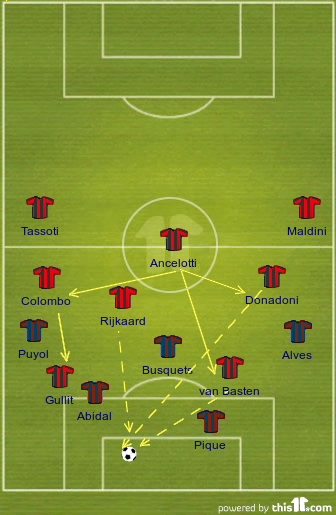
On the other hand, owing to the advanced positions of Rijkaard and Ancelotti and their telepathic understanding to exchange passes on flanks with either of Donadoni or Colombo immediately elevates Sergio Busquests’ job to another level altogether. The young Spanish midfielder, who usually guards the Centre Backs sitting deep may not enjoy that liberty and must operate higher up the pitch to reduce the passing options of the Milanese midfielders.
Milan enjoy a clear numerical advantage in the midfield but the fact that none of their players forming the ‘4’ of midfield is a naturally defensive one may work against them. The unending grit and perseverance with which Xavi and Iniesta operate for 90 minutes, more than suggests that they can generate a moment of brilliance or two outplaying Rijkaard and Ancelotti to find the likes of Pedro and Villa in the best of positions but the two wingers would definitely have the worst of their times dealing with Tassoti and Maldini guarding the flanks.
The usual tactics that the two mangers deploy slightly tilts in Milan’s favor in the center area as they propose a better chance to exploit Barcelona’s area of vulnerability in defense.
The Messi Factor against Baresi
The Argentine dynamite is undoubtedly the best player of the generation he belongs to but the purists of the bygone era have often questioned the quality of the defenses he has fared against. There are theories that suggest he would not be as effective against the classy defenders of times elapsed. However, should he successfully run riots against a defense led by someone of Franco Baresi’s stature, all the speculations questioning his preternatural talent may be put to rest.
Sacchi would prefer to remain cautious against the natural fluidity in Messi’s movement despite fielding the most resolute defense ever. Unlike his usual play attributes, Messi would need to alter his game to succeed past Baresi. Over the course of last couple of seasons, Messi has redefined the parameters of versatility executing multiple roles of Winger, Centre Forward and playmaker on his duties representing the club and the country. The same tractability has to remain on show from Messi as the authority that Milan’s centre midfield may establish in the Barca half may require him to drop deep down in his own half and be involved into the very build-up process. Once again, that nearly doubles the distance he may need to run to position into a potential striking zone.
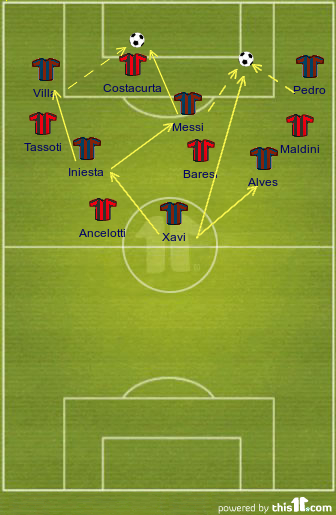
To track Messi’s movements and negate any threat from his side, Alessandro Costacurta would undoubtedly be Sacchi’s trump card. The Milan academy product should remain stationed at the deepest end of pitch and could be the ideal candidate to man-mark the little Argentine. There are bright chances of Messi’s pace being subjugated by Baresi much before he poises any real threat and he may have to divert his attacks to either Villa or Pedro who are fielded wide in the attacking third.
The ‘Dutch’ Job to Be Handled By Carles Puyol
The bi-directional attack of the Milan side is spearheaded by the Dutch duo of Ruud Gullit who plays just off Marco van Basten in a highly classified 4-4-2 blueprint. Along with the attacking pair, Roberto Donadoni and Angelo Colombo, who man the two wings are the ones who deal at lightning paces utilizing the width of the pitch to the fullest. In Sacchi’s trademark high-held line of midfield, Rijkaard and Ancelotti have multiple options to skip past the center midfield of Barcelona and direct play from either of the wings.
What this may effectively do is suppress the ambitions of Barcelona Full Backs Daniel Alves and Eric Abidal in order to chase Milan’s inverted wingers into their own half. As it was observed during the last season when Barcelona faced Real Madrid at Bernabeu in the first leg of the Champions League Semi-Finals, Alves and Puyol tended not to push forward despite acres of room to work around with which explains the change in Guardiola’s approach against sides which may trouble them at flanks.
In order to deal with Ruud Gullit’s incisive dribbling in the Barcelona half; Carles Puyol might be chosen ahead of Eric Abidal to guard the right flank as the French defender is equally effective in the centre too forming a solid partnership with another academy graduate Gerard Pique. Puyol, the captain who leads the team ‘from the back’ is a classy defender and should once again rise to the occasion to subdue the impact of a phenomenon called Marco van Basten.
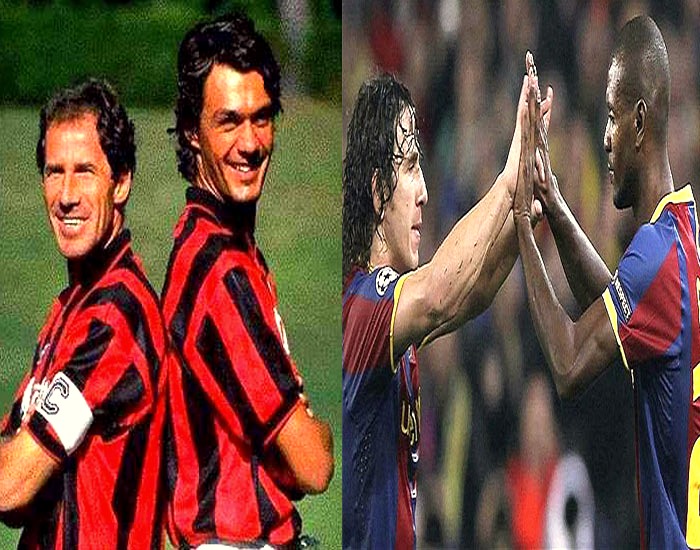
The usual Barcelona ‘philosophy’ to hold on to the ball may be disturbed a little dealing with the Milan attack as the Full Backs would not be able to overlap the wingers as flawlessly as they usually do against their present day opponents in both Spain and in Europe.
The Possible Outcomes
From the looks of it, the major area of concern for Arrigo Sacchi is the center of midfield where there is no defense-minded player operating which may lead to Milan being outnumbered in their own half the moment Xavi and Iniesta manage to draw the ball past Rijkaard or Ancelotti. However, how successfully Barcelona are able to materialize any such move further depends on their maneuvering of passes in the final third as breaking the great Milanese wall of defense is no mean task.
On the other hand, Milan have number of options to dismantle the Barcelona system as the Catalonian outfit is not exactly used to be dealing with teams who hold an alarmingly high line during the entire course of the game. Given the core strength of both teams and the tactical acumen of both managers, the pendulum swings in the favour of Sacchi’s Milan, although very slightly. The contest, if at all transpires guarantees to be of monumental proportion enrapturing all sets of fans. The match would be nothing short of realization of a long nurtured dream for the lovers of the sport.
